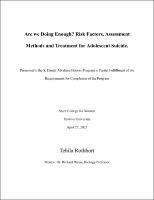Please use this identifier to cite or link to this item:
https://hdl.handle.net/20.500.12202/9022| Title: | Are we doing enough? Risk factors, assessment methods and treatment for adolescent suicide. |
| Authors: | Weiss, Richard Rothbort, Tehila |
| Keywords: | teen suicide adolescents Ask Suicide-screening Questions (ASQ) Suicide Severity Rating Scale (C-SSRS) suicide assessment effective treatment plan (suicide) |
| Issue Date: | 27-Apr-2023 |
| Publisher: | Yeshiva University |
| Citation: | Rothbort, T. (2023, April 27). Are we doing enough? Risk factors, assessment methods and treatment for adolescent suicide [Unpublished undergraduate honors thesis]. Yeshiva University. |
| Series/Report no.: | S. Daniel Abraham Honors Program;April 27, 2023 |
| Abstract: | Suicide is defined as “a fatal self-injurious act with some evidence of intent to die” (Turecki, 2016). This definition, although true, is only part of the story. Suicide is the second leading cause of death in children aged 10-14, and is the third leading cause of death in adolescents aged 15-19 (CDC, n.d.). These statistics, although heartbreaking, are not surprising. According to the CDC, suicidal ideation has been on the rise in teens and adolescents aged 10-24, with a 57.4% increase from 2007 to 2018 (Curtin, 2020). Identifying common risk factors and early signs of suicidal ideation can be crucial in slowing this trend. These factors include comorbid mental illnesses, past suicide attempts, substance abuse, loss of loved ones, and unhealthy or violent relationships. Additionally, many doctors and other mental health specialists use common assessments such as the Ask Suicide-screening Questions (ASQ) or the Columbia Suicide Severity Rating Scale (C-SSRS) to assess suicidal ideation in adolescents. However, these screening tools were created for specific settings and are, therefore, not generalizable to other populations. Therefore, after interviewing a mental health professional, this paper will present a clear understanding of a suicidal assessment for young adults. Additionally, common treatment methods for suicide, such as inpatient hospitalization and outpatient settings will be compared to attempt to identify the most effective method of treating suicidality in children and adolescents. This paper aims to develop an understanding of the stage of adolescence, the risk factors associated with suicide, the proper assessment methods, and ultimately focus on developing the most effective treatment plan for suicidal adolescence. 3 |
| Description: | Undergraduate honors thesis / Opt-Out |
| URI: | https://hdl.handle.net/20.500.12202/9022 |
| Appears in Collections: | S. Daniel Abraham Honors Student Theses |
Files in This Item:
| File | Description | Size | Format | |
|---|---|---|---|---|
| Tehila Rothbort Honors Thesis OptOut Apr2023.pdf | 447.81 kB | Adobe PDF |  View/Open |
This item is licensed under a Creative Commons License

